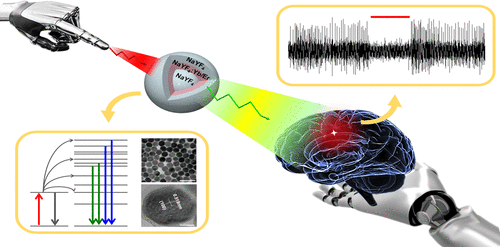当前位置:
X-MOL 学术
›
Nano Lett.
›
论文详情
Our official English website, www.x-mol.net, welcomes your
feedback! (Note: you will need to create a separate account there.)
Core–Shell–Shell Upconversion Nanoparticles with Enhanced Emission for Wireless Optogenetic Inhibition
Nano Letters ( IF 9.6 ) Pub Date : 2018-01-02 00:00:00 , DOI: 10.1021/acs.nanolett.7b04339 Xudong Lin 1 , Xian Chen 2, 3 , Wenchong Zhang 1 , Tianying Sun 2 , Peilin Fang 1 , Qinghai Liao 4 , Xi Chen 5 , Jufang He 5 , Ming Liu 4 , Feng Wang 2, 6 , Peng Shi 1, 6
Nano Letters ( IF 9.6 ) Pub Date : 2018-01-02 00:00:00 , DOI: 10.1021/acs.nanolett.7b04339 Xudong Lin 1 , Xian Chen 2, 3 , Wenchong Zhang 1 , Tianying Sun 2 , Peilin Fang 1 , Qinghai Liao 4 , Xi Chen 5 , Jufang He 5 , Ming Liu 4 , Feng Wang 2, 6 , Peng Shi 1, 6
Affiliation

|
Recent advances in upconversion technology have enabled optogenetic neural stimulation using remotely applied optical signals, but limited success has been demonstrated for neural inhibition by using this method, primarily due to the much higher optical power and more red-shifted excitation spectrum that are required to work with the appropriate inhibitory opsin proteins. To overcome these limitations, core–shell–shell upconversion nanoparticles (UCNPs) with a hexagonal phase are synthesized to optimize the doping contents of ytterbium ions (Yb3+) and to mitigate Yb-associated concentration quenching. Such UCNPs’ emission contains an almost three-fold enhanced peak around 540–570 nm, matching the excitation spectrum of a commonly used inhibitory opsin protein, halorhodopsin. The enhanced UCNPs are utilized as optical transducers to develop a fully implantable upconversion-based device for in vivo tetherless optogenetic inhibition, which is actuated by near-infrared (NIR) light irradiation without any electronics. When the device is implanted into targeted sites deep in the rat brain, the electrical activity of the neurons is reliably inhibited with NIR irradiation and restores to normal level upon switching off the NIR light. The system is further used to perform tetherless unilateral inhibition of the secondary motor cortex in behaving mice, achieving control of their motor functions. This study provides an important and useful supplement to the upconversion-based optogenetic toolset, which is beneficial for both basic and translational neuroscience investigations.
中文翻译:

核-壳-壳上转换纳米粒子具有增强的发射能力,可用于无线光遗传抑制。
上变频技术的最新进展已使得能够使用远程施加的光信号进行光遗传学神经刺激,但是使用这种方法对神经抑制的成功有限,主要是因为需要更高的光功率和工作所需的更多红移激发光谱与适当的抑制性视蛋白蛋白结合。为克服这些限制,合成了具有六方相的核-壳-壳上转换纳米粒子(UCNPs),以优化离子(Yb 3+)并减轻与Yb相关的浓度猝灭。此类UCNP的发射在540-570 nm附近包含一个几乎三倍的增强峰,与常用的抑制性视蛋白蛋白,卤代视紫红质的激发光谱相匹配。增强的UCNP被用作光传感器,以开发用于体内的完全可植入的基于上转换的设备无系带光遗传学抑制,这是由近红外(NIR)光辐照而没有任何电子器件引起的。当将该设备植入大鼠脑深处的目标部位时,神经元的电活动会被NIR辐射可靠地抑制,并在关闭NIR光后恢复到正常水平。该系统还用于对行为小鼠的次级运动皮层进行无系链的单侧抑制,从而实现对它们运动功能的控制。这项研究为基于上转换的光遗传学工具集提供了重要而有用的补充,这对于基础神经科学和转化神经科学研究都是有益的。
更新日期:2018-01-02
中文翻译:

核-壳-壳上转换纳米粒子具有增强的发射能力,可用于无线光遗传抑制。
上变频技术的最新进展已使得能够使用远程施加的光信号进行光遗传学神经刺激,但是使用这种方法对神经抑制的成功有限,主要是因为需要更高的光功率和工作所需的更多红移激发光谱与适当的抑制性视蛋白蛋白结合。为克服这些限制,合成了具有六方相的核-壳-壳上转换纳米粒子(UCNPs),以优化离子(Yb 3+)并减轻与Yb相关的浓度猝灭。此类UCNP的发射在540-570 nm附近包含一个几乎三倍的增强峰,与常用的抑制性视蛋白蛋白,卤代视紫红质的激发光谱相匹配。增强的UCNP被用作光传感器,以开发用于体内的完全可植入的基于上转换的设备无系带光遗传学抑制,这是由近红外(NIR)光辐照而没有任何电子器件引起的。当将该设备植入大鼠脑深处的目标部位时,神经元的电活动会被NIR辐射可靠地抑制,并在关闭NIR光后恢复到正常水平。该系统还用于对行为小鼠的次级运动皮层进行无系链的单侧抑制,从而实现对它们运动功能的控制。这项研究为基于上转换的光遗传学工具集提供了重要而有用的补充,这对于基础神经科学和转化神经科学研究都是有益的。











































 京公网安备 11010802027423号
京公网安备 11010802027423号